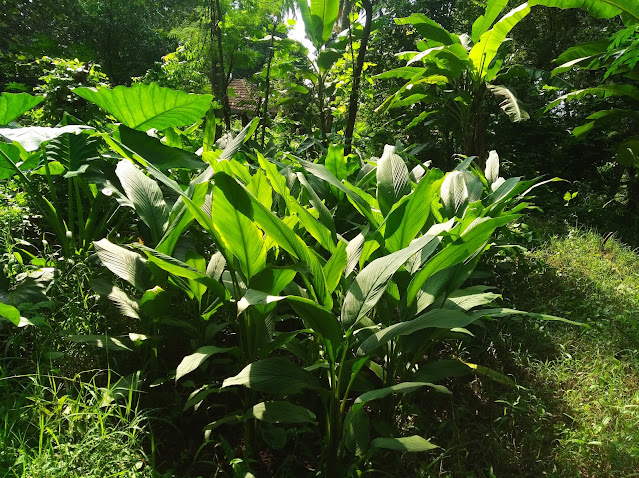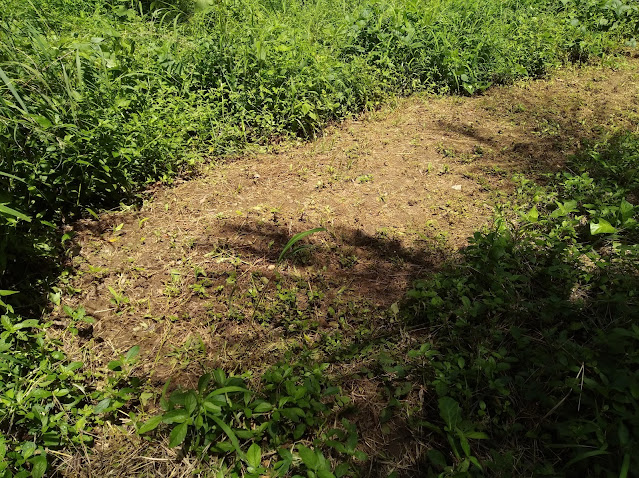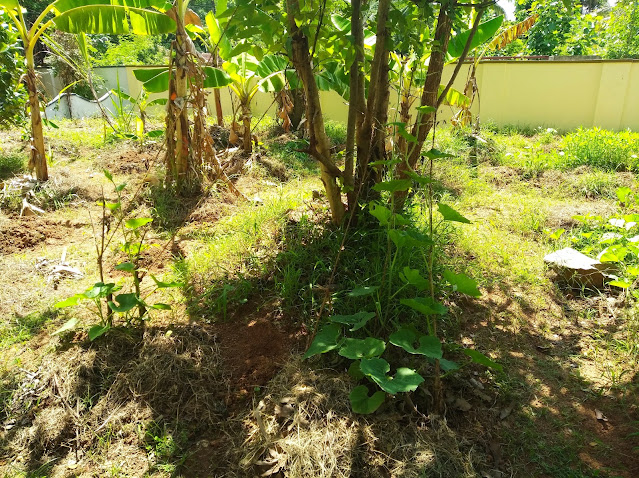Thursday, November 4, 2021
Taro harvesting and seeding again
Tuesday, October 26, 2021
Not much tillering in no-till rice?
This year have been doing some experiments with no-till rice. One field is in the farm using Pureria as cover crop which had controlled all strong grasses and gave a clean field to start no-till rice. Had removed all the cut Pureria to one side and sown the pre-germinated rice seeds of an upland variety called 'Katta modan'. The density was more and there was good line spacing. But could see that there is no tillering for the rice. One reason could be that no-fertilizer and soil open to sun and rain, built fertility would have lost? When conventional fields are compared, they till the soil and all the grass and straw will be allowed to decompose and then transplanting starts. Even though field is plowed, it is made fertile and hence growth of rice plants is better.
In natural farming no-till field, even Fukuoka san recommended 600-900 pounds of well decomposed chicken manure per quarter acre. So this is some thing to be seriously considered. Also the field should be covered with mulch.
Thursday, October 21, 2021
Turmeric Crop
This year tried a turmeric crop and it was doing well so thought of analyzing what went well. One thing is that soil where this was tried was reasonably deep after years of mulching and not disturbing much. Also in this patch, distance between fingers were almost a foot and this was suggested by worker, he always tell if there is good distance it is better.
Also after couple of months, this was weeded and compost was applied and soil put over this compost and then mulched with fodder grass which decomposes very slowly hence soil cover was there.
Friday, October 15, 2021
Happy Hill Rice
Even though I tried some seeds in March-April as soon as I had received it, knew that is not the actual season, so trying it with monsoon when the temperature is cool and ground is wet. The seeds received were not very healthy, lots of plants turn yellowish and die. But in one area, could get some harvest, so trying those seeds again, so they are happy hill rice grown in this climate being tried out again here.
12-October-2021
The seeds used were harvested in around August end 2021.
Have put around 130 seeds in grow bags, after soaking them in cowdung water for 24 hours. Soaking may have to be reduced to 12 hours, that is the typical practice, some where I thought it is 24 hours and kept it. After 3-4 days, rice seedlings are seen.19-October-2021
22-Oct-21
Transplanted the seedlings..1/2 seedlings in every 10cms. Also broadcasted some fenugreek seeds as a ground cover. It rained heavily at the night, so not sure, if fenugreek will germinate.
Applied cut leaves of mexican sunflower throughout to keep the soil covered and also applied some fresh cowdung slurry
No-till corn - small patch
Have been growing in small patches in backyard and with that experience wanted to try it in the farm in small area. To the extend possible, wanted to try it in minimum tillage way, hence cut the tall grass in the raised bed using Scythe and then cut it short to ground using brush cutter. This is the combination I am using, Scythe allows to cut the tall grasses easily but since it is heterogenous grass, cutting may be not be that neat, there the brush cutter helps. If there are millipedes, they will be hurt badly, so I just pick them move away before cutting. This can be done with a stick very easily.
I put a line using Homi hoe and put two seeds at 1 feet and covered it using the same tool, but germination was very poor. One is that if the moisture content is not good, germination will be bad and also could see that ants taking away seeds immediately after sowing.
Next time, made sure that there was enough moisture in the soil and also dipped seeds in turmeric powder paste and sown, most of the seeds germinated, was happy about that. A few places it didn't germinate, those places put the seeds once again. Finding that a uniform crop stand is a must to get good yield, so may have to put seeds couple of times, or worst case transplant to places where there is a gap. Also from previous experience, distance between corn plants should be large, at least 1 feet so that plants grow healthy. Now I am seeing, the planting distance really matters...SRI rice tells 1 feet distance, similarly lots more evidence on this..Fukuoka San also tells sparse seeding is good.
Tuesday, October 12, 2021
Mexican sunflower
Used to see Mexican Sunflower in Youtube videos and permaculture articles, where it is called as a Dynamic Accumulator. But never was there a mention from any local farmers or any one in the farming community. Happened to see them on road sides and started looking them closely and started reading more. Took some cuttings from road sides and planted at home and they were growing quite fast, so was impressed. Then thought of introducing them to farm, since any biomass generator and diversity addition is good for the farm.
This year planted them around newly planted saplings and also near the trenches. Recently planted 3 cuttings on the front yard where one chaya mansa tree had fallen from ant attack and we lost the shade in the front porch. Mexican sunflower cuttings grew in 4 months and brought back that shade.
Showed this plant to my helper Palani and he said he has seen them in big bunches on road sides and went with him and collected lots of cuttings and planted around trenches and as shade for saplings.
Mexican sunflower planted to provide shade for the newly planted fig saplings
Tuesday, October 5, 2021
Reviving soil with Mucuna - Video from https://www.accessagriculture.org/
I am not growing Mucuna, but this article gives some inputs from the video
https://www.accessagriculture.org/reviving-soils-mucuna.
Mucuna is a vigorous leguminous perennial creeper cover crop used in plantations. In Kerala it is seen in rubber plantations. It is not good for cattle, there are reports that it may kill cattle, if eaten in large quantities. Since it is perennial and vigorous creeper, once established all the weeds will be gone. When I was looking for perennial cover crops, this was one option for me. But since it may kill grazing animals, didn't prefer it, and went for Pureria. Even though both Mucuna and Pureria generates enormous amount of biomass, but never seen anyone using it in orchards. So when I saw Mucuna being used in West Africa for regenerating soil, I was amused.
The following scenarios are discussed in the video..
West africa has 2 rainy seasons, major rainy season from April through June and short rainy season from October through December. Farmers typically grow maize and casava with start of the rain. After maize is harvested casava continues and then casava is harvested. Some farmers do two maize crops and with erratic rains, they may not get a second harvest. Also since nothing is returned to soil, soil depletes and maize harvest declines. To regenerate soil some farmers plant mucuna in between maize when maize crop has completed 60 days, by this time pods would have formed. Planting is done between maize rows.
Maize is planted at 80cms distance between rows and 40cms within rows. 2 maize seeds are planted in one hole. Maize field will be weeded before planting Mucuna.60Kgs of Mucuna seeds are required per hectre. Every 40cms, two seeds will be dropped in the hole and covered. By the time maize is harvested Mucuna grows over maize and this continues till the end of the short rainy season. After this, thick layer of mulch decomposes in the summer. With first rain, they sow seeds of maize and some farmers do this without ploughing. If the soil is poor, they advise to sow Mucuna for 3 years and after that on alternate years.
Mucuna improves the soils and also gets rid of some difficult weeds. After the rain field with Mucuna remains, there is little run off and retains water, while field without Mucuna,water just runs off. Soils with Mucuna is soft and easy to work with rain, while the other fields become hard. Even without tilling planting becomes possible with Mucuna left over. Conventionally they harvest 10 bags of maize per hectre and with Mucuna it is 30 bags per hectre.Similarly for Casava, it is 30 bags of flour per hectre with Mucuna and 4-5 bags of flour without Mucuna
Here is the video which tells how they use Mucuna for regenerating soil.
https://www.accessagriculture.org/reviving-soils-mucuna
Conclusion
Since Mucuna grows very fast and fixes lots of nitrogen and generates lots of biomass, it is a good option to grow that as a cover crop after the harvest of the rice, this typically gives around 8 months of growth, considering a 4 month duration rice variety. If the mucuna is sown 1 month before harvest of rice, this can become 9 months. If we go for two crops, each with duration of 4 months, we can still grow it for 5 months. One problem is that seeds are not readily available.
Thursday, August 19, 2021
Peahen mother
Some tribal agriculture details - Attappadi,Kerala
Recently attended a webinar about tribal agriculture of Attapadi a hilly area in Kerala. This happened on farmer's day and one outstanding farmer called Unnikrishnan was honored in this meeting. Later collected his phone number and talked to him. Thought of sharing some informations collected from him..
He is from tribal community in Attapadi and stays in the same area. He was earlier working in Navy and took retirement to take care of his family and got into full time farming. He grows rice, millets and vegetables. New fallow areas are leased on every year and he does cultivation, idea is to make sure that there are no fallow areas and encourages people to get into farming. Lots of people leave the farm in fallow and take up other works and also depend on government supplied ration and ultimately they become malnourished.
Rice grown is a traditional variety which is used in that locality but there is no name for it. It is a 6 months duration crop and 4kgs sown gives a yield of 300Kgs. It reaches chest height and grows with many tillers. Generally they will be sown sparsely and will be intercropped with sunflower so that there will be less pest attack. Sunflower seed will be used minimally so that they don't interfere with rice.
On the buds, they grow a local variety pumpkin which is a small fruit variety and this makes sure that bunds are weed free.
Millets are cultivated and he says, right now they have 300Kgs of finger millets on stock. Tribal people typically cultivate for their own food, selling is the last choice for them. There are wild animal and birds attack, but they think that they are growing food for them and wild animals and birds. They see it as a good sign, if wild animals come and eat, so that next year they will have a better crop. This is an amazing way of living together with nature.
He asked me to visit them with family so that we can understand it better....
Shade for newly planted saplings
I have planted many fruit tree saplings on this monsoon season. There won't be any irrigation as of now in the farm for them. So planning to grow mexican sunflower cuttings nearby to each saplings. Typically around 2-3 feet away from the saplings and in opposite direction, so that mulching can be still done without much disturbance.
Still have to get more cuttings of mexican sunflower, I can see them growing on road sides, have to cut and take them. If they grow and provide shade, I am thinking saplings will survive the summer.
Fodder grass
Sunday, July 25, 2021
Planting lots of mango trees
On this monsoon trying to plant lots more mango trees in unused spaces. Mainly lots of traditional mangoes which does not require much attention. Bought around 55 mango saplings, all grafted and along with planted 3 kolumbu saplings from seeds, so far totally 58 trees.
The varieties bought were - Kolumbu - 30, Kalapadi - 10, Karpooram -3, Kotturkonam - 4, Natasala - 4,Olor - 2,Nambiar - 1,Kottaparamban - 1. Most of these are bought from Rayirath Gardens, Pattikkad, Thrissur and South Indian Agri farm, Thrissur.
Some of the planted mangoes..
Wednesday, July 21, 2021
Kolumbu Mango from seeds
I keep hearing that some mango varieties produce the same type fruits even grown from seeds, first heard this from facebook group 'nadan mavukal' (traditional mangoes).
People say Kolumbu,Chandrakkaran, Moovandan etc... produce same type fruits. Trying Kolumbu from seeds this time.
Saplings are 1 year old, seeds from my farm itself, the smaller Kolumbu mango tree.
Monday, June 7, 2021
Cultivation in neighborhood area
When Corona lockdown started, my neighbor had given some land for me to cultivate. I had started banana, brinjal,chinese potato etc...In summer nothing much happened since watering is always a problem. So with the rain again I have started again. Also I make compost with kitchen waste and dried leaves, green grass etc...right now one pile is almost ready and another will be ready in two months...
Some photos...
This is ready for use..will be covering it with plastic sheet so that rain and sun does not fall on it directly.
Blue taro - favorite of wild pigs - hence covered with bamboo and other thorny branches
Sugar cane plant - survived summer
Cow pea
14-August-2021
Chinese poatoe - applied cowdung once and compost couple of times
Planted new banana in places where the earlier one was damaged
Lady's finger and chilly plant..ladies finger was seeded 3 times since initially it didn't germinate
Brinjal - steady harvest for 2nd year...
Super napier grass seeds germinating
Super napier grass and vetiver grass
This is a lady's finger gifted by a neighbor grand mother few years back...yields well
After some time, branches comes and on each branch there are fruits
New compost pile
Compost pile is almost ready


















































































